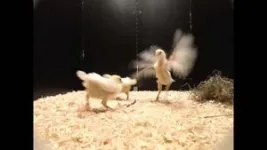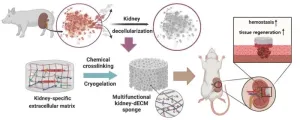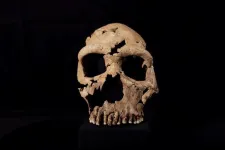(Press-News.org) Osaka, Japan – It might start simply, with a cough or sneeze…but in some cases, the flu virus can make its way to your brain, causing serious symptoms or even death through a disease known as influenza-associated encephalopathy (IAE).
Now, in a study published in Acta Neuropathologica, researchers have revealed that IAE may be caused by the virus entering the brain through a specific cell type, and have identified possible treatment strategies.
Although IAE is increasingly common, surprisingly little is known about how the influenza virus actually gets into the brain and causes symptoms of encephalopathy (a general term for brain disorders). Notably, a definitive treatment for IAE remains lacking, something that researchers from Osaka University wanted to address.
To study how influenza viruses might cause IAE, the research team used a range of methods. As well as looking for virus particles in the brains of people who died from IAE, they created a mouse model of the disease by injecting influenza A virus into the blood. They also used cell culture methods to look at how well the virus infects different cell types.
“In the human brains, the virus-injected mice, and the cultured cells, the influenza virus tended to accumulate in endothelial cells,” explains lead author of the study Shihoko Kimura-Ohba. “These cells create a barrier between the blood and the brain, and are important for protecting the brain from harmful substances.”
Accordingly, in both the human brains and the mouse model, the barrier between the blood and the brain was compromised. Furthermore, the researchers noticed that the virus wasn’t actually reproducing within these endothelial cells—but there were a lot of proteins made by the virus.
“When we saw this viral protein accumulation in the brain, we realized that antiviral medications aimed at stopping viral proliferation were unlikely to help,” says Tomonori Kimura, senior author of the study. “However, antivirals aimed at stopping viral transcription and translation—vital processes for making proteins—are also available.”
When the team tried these classes of antivirals in endothelial cells treated with influenza virus, they observed less viral proteins and cell death. In the mouse model of IAE, these antivirals were also very effective when used early enough, suggesting that they may be useful in human patients.
Given that many different kinds of viruses, including COVID-19, can cause encephalopathy, these findings have wide-ranging impacts. Moreover, although IAE care is improving, more than half of all patients die or have long-lasting symptoms. A better understanding of how viruses can cause encephalopathy will be important for developing new, effective treatments.
###
The article, “Viral entry and translation in brain endothelia provoke influenza-associated encephalopathy,” was published in Acta Neuropathologica at DOI: https://doi.org/10.1007/s00401-024-02723-z
About Osaka University
Osaka University was founded in 1931 as one of the seven imperial universities of Japan and is now one of Japan's leading comprehensive universities with a broad disciplinary spectrum. This strength is coupled with a singular drive for innovation that extends throughout the scientific process, from fundamental research to the creation of applied technology with positive economic impacts. Its commitment to innovation has been recognized in Japan and around the world, being named Japan's most innovative university in 2015 (Reuters 2015 Top 100) and one of the most innovative institutions in the world in 2017 (Innovative Universities and the Nature Index Innovation 2017). Now, Osaka University is leveraging its role as a Designated National University Corporation selected by the Ministry of Education, Culture, Sports, Science and Technology to contribute to innovation for human welfare, sustainable development of society, and social transformation.
Website: https://resou.osaka-u.ac.jp/en
END
Promising new treatment strategy for deadly flu-related brain disorders
Researchers from Osaka University find that some influenza-associated brain disorders may be caused by the virus entering the brain and making proteins, suggesting that antivirals that block protein production might be an effective treatment
2024-05-02
ELSE PRESS RELEASES FROM THIS DATE:
Scientists’ new approach in fight against counterfeit alcohol spirits
2024-05-02
In the shadowy world of counterfeit alcoholic spirit production, where profits soar and brands are exploited, the true extent of this illegal market remains shrouded.
Now scientists from the International Centre for Brewing and Distilling (ICBD) at Heriot-Watt University, in Edinburgh, Scotland, working alongside Dr John Edwards of Process NMR Associates, based in New York, are compiling a database to test, compare and log counterfeit spirits.
The research has featured in a paper, titled, Worldwide Illicit and Counterfeit ...
Cost-effective, high-capacity, and cyclable lithium-ion battery cathodes
2024-05-02
Charge-recharge cycling of lithium-superrich iron oxide, a cost-effective and high-capacity cathode for new-generation lithium-ion batteries, can be greatly improved by doping with readily available mineral elements.
The energy capacity and charge-recharge cycling (cyclability) of lithium-iron-oxide, a cost-effective cathode material for rechargeable lithium-ion batteries, is improved by adding small amounts of abundant elements. The development, achieved by researchers at Hokkaido University, Tohoku University, and Nagoya Institute of Technology, is reported in the journal ACS Materials Letters.
Lithium-ion batteries have become indispensable in modern life, used in a multitude ...
Artificial intelligence enhances monitoring of threatened marbled murrelet
2024-05-02
CORVALLIS, Ore. – Artificial intelligence analysis of data gathered by acoustic recording devices is a promising new tool for monitoring the marbled murrelet and other secretive, hard-to-study species, research by Oregon State University and the U.S. Forest Service has shown.
The threatened marbled murrelet is an iconic Pacific Northwest seabird that’s closely related to puffins and murres, but unlike those birds, murrelets raise their young as far as 60 miles inland in mature and old-growth forests.
“There are very few species like it,” said co-author Matt Betts of the OSU College of Forestry. “And there’s no ...
The solution to kidney bleeding and recovery lies within a hemostasis sponge, using the inherent capabilities of the kidneys
2024-05-02
Professor Dong-Woo Cho from the Department of Mechanical Engineering along with Jae Yun Kim, a PhD candidate, from the School of Interdisciplinary Bioscience and Bioengineering and Tugce Sen, a PhD student, from Department of Mechanical Engineering at POSTECH, teamed up with Professor Jae Yeon Lee from Daegu Haany University's Department of Companion Animal Health. Together, they crafted a material aimed at swiftly staunching kidney bleeding and facilitating wound recovery. Their research featured in the online edition of Biomaterials, an ...
Sylvester Cancer adding cellular therapy to its arsenal against metastatic melanoma
2024-05-02
MIAMI, FLORIDA (May 1, 2024) – Patients in South Florida with metastatic melanoma will soon have access to the first cellular therapy for this advanced form of skin cancer, following its recent approval by the Food and Drug Administration (FDA). The therapy, known as tumor-infiltrating lymphocyte therapy, or TIL, uses patients’ own immune cells to battle their cancer. It will be available to patients at Sylvester Comprehensive Cancer Center at the University of Miami Miller School of Medicine as South Florida’s only center offering ...
Study finds biomarkers for psychiatric symptoms in patients with rare genetic condition 22q
2024-05-02
A recent study led by UC Davis Health researchers provides new insights into the molecular changes linked to the rare genetic condition 22q11.2 deletion syndrome, or 22q. It found unique biomarkers that could identify patients with 22q who may be more likely to develop schizophrenia or psychiatric conditions, including psychosis, which is commonly associated with 22q. The research was published in the journal Metabolomics.
People with 22q are missing a piece of chromosome 22 that contains more than 30 genes. This loss can lead to a variety of health challenges, ...
Medical school scientist creates therapy to kill hypervirulent bacteria
2024-05-02
University of Central Florida College of Medicine researcher Renee Fleeman is on a mission to kill drug-resistant bacteria, and her latest study has identified a therapy that can penetrate the slime that such infections use to protect themselves from antibiotics.
In a study published recently in Cell Reports Physical Science, Fleeman showed that an antimicrobial peptide from cows has potential for treating incurable infections from the bacterium Klebsiella pneumoniae. The bacteria, commonly found in the intestines, is usually harmless. ...
New study supports psilocybin’s potential as an antidepressant
2024-05-02
Psilocybin - the active ingredient in “magic” mushrooms - is a more effective treatment for symptoms of depression than controls, providing further support for its potential as an antidepressant, suggests a study published by The BMJ today.
The researchers say the findings are encouraging but “further research is needed to clarify the factors that maximise psilocybin’s treatment potential for symptoms of depression.”
Depression affects an estimated 300 million ...
The Lancet Public Health: Global study reveals stark differences between females and males in major causes of disease burden, underscoring the need for gender-responsive approaches to health
2024-05-02
Global and regional analyses reveal persistent health differences between females and males across the 20 leading causes of disease burden (illness and death—quantified as health loss) over the past 30 years.
Overall, health loss is higher in males, particularly driven by premature death; but females, despite tending to live longer, endure higher levels of illness over their lives—underscoring the diverse and evolving health needs of men and women at different stages of their lives.
These health differences emerge in adolescence highlighting the importance of early interventions and measures to prevent the onset and exacerbation ...
Revealed: face of 75,000-year-old female Neanderthal from cave where species buried their dead
2024-05-02
A new Netflix documentary has recreated the face of a 75,000-year-old female Neanderthal whose flattened skull was discovered and rebuilt from hundreds of bone fragments by a team of archaeologists and conservators led by the University of Cambridge.
The team excavated the female Neanderthal in 2018 from inside a cave in Iraqi Kurdistan where the species had repeatedly returned to lay their dead to rest. The cave was made famous by work in the late 1950s that unearthed several Neanderthals which appeared ...
LAST 30 PRESS RELEASES:
New fossil study illuminates on the evolutionary success of frogs
Patient-specific human liver model to understand disease mechanisms
Confused by the doctor's questionnaire? U of A study suggests it's common
How do brains stay stable, and when might a dose of flexibility be helpful?
mRNA revitalizes aging immune systems—the liver as a fountain of youth
Rural-urban differences in the prevalence of chronic pain among adult cancer survivors
Food insecurity, burnout, and social isolation among resident and fellow physicians
How do spinal cord injuries heal?
Detailed cell map unlocks secrets of how reproductive organs form
Large language models unleash AI’s potential for autonomous and explainable materials discovery
Gut bacteria have evolved rapidly to digest starches in ultra-processed foods
New risk score helps predict pancreatic cancer recurrence
New evidence challenges understanding of Parkinson’s disease
A new study reveals how embryos and the uterus “talk” during implantation
Cedars-Sinai reports heart attacks, general illness spiked after LA fires
PolyU develops ultra-stable, mucus-inspired hydrogel to boost gastrointestinal wound healing
Flour choice shapes sourdough microbial communities
Can a retinal implant reverse macular degeneration?
Feeding fungi plant remnants produces tasty protein to fortify vegan, vegetarian diets
New tech reduces false positives from breast ultrasounds
Drone-mounted lab monitors fertilizer runoff in real time
Short, light-intensity exercise boosts executive function and elevates mood in children
Jeonbuk National University researchers reveal new interface engineering strategy for efficient and stable back-contact solar cells
Tyrosinase drives hydroquinone-induced exogenous ochronosis: not HGD inhibition
UMass Amherst chemists develop unique tool for studying RNA
Disappointment alters brain chemistry and behavior
A built-in odometer: new study reveals how the brain measures distance
Stress-related brain signals drive risk of cardiovascular disease in people with depression and anxiety
New details on role of fat transport molecules in Alzheimer’s onset
Study illuminates how an antiviral defense mechanism may lead to Alzheimer’s disease
[Press-News.org] Promising new treatment strategy for deadly flu-related brain disordersResearchers from Osaka University find that some influenza-associated brain disorders may be caused by the virus entering the brain and making proteins, suggesting that antivirals that block protein production might be an effective treatment








